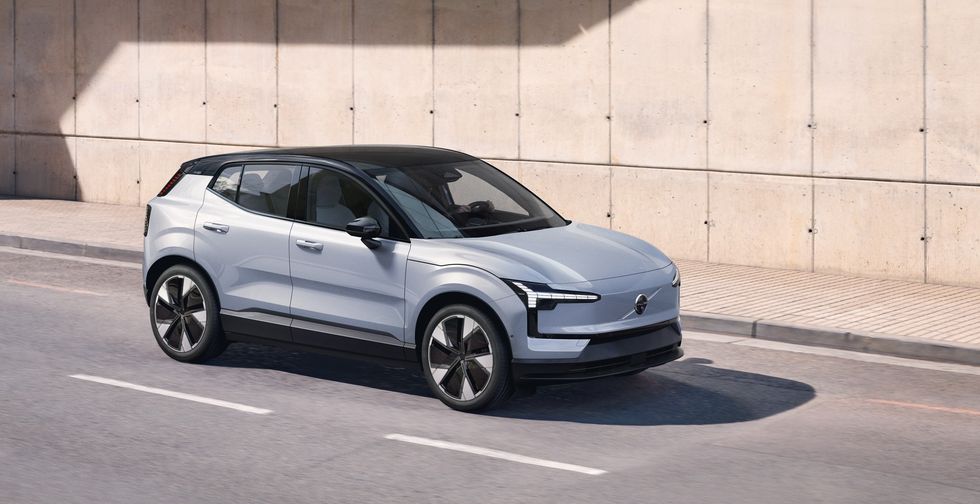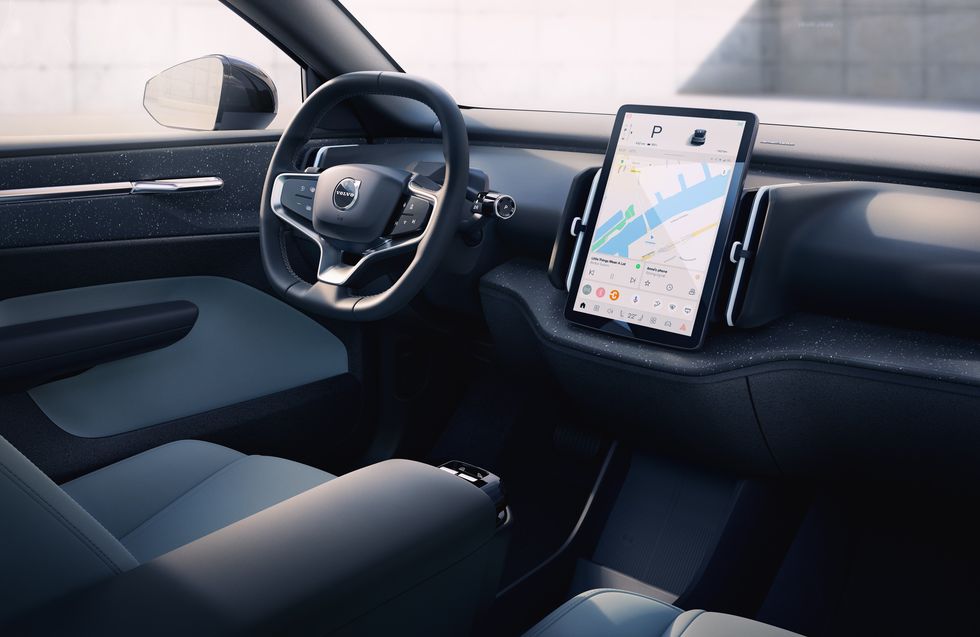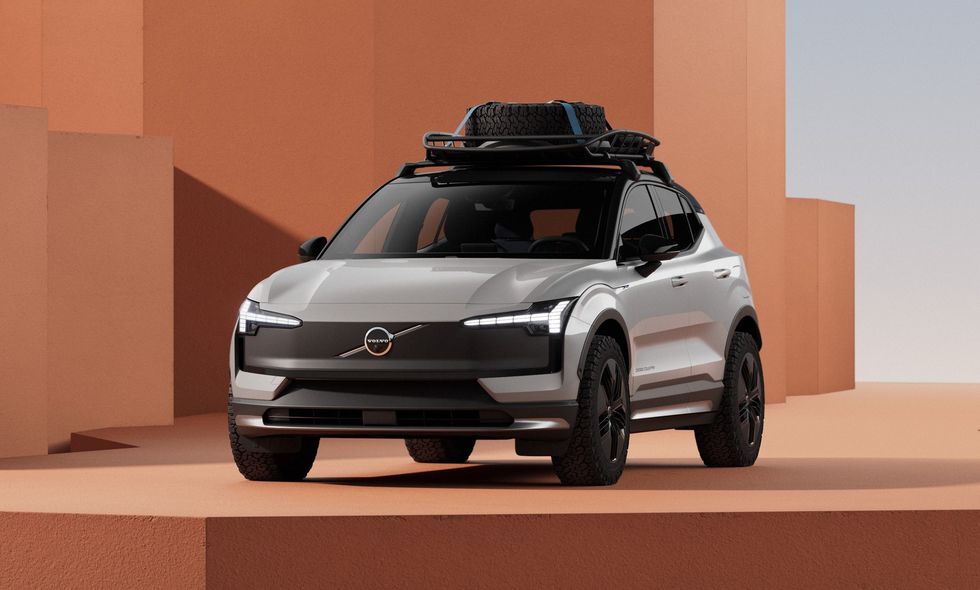- On the heels of a production delay for the larger EX90, Volvo is launching a small electric crossover known as the EX30 and pricing will start at $34,950.
- With three powertrain options and two different battery packs, the EX30 has the possibility to go 298 miles per charge or accelerate from 0-60 mph in 3.6 seconds.
- Using 30% less metal and a host of sustainable interior materials, the Chinese-produced EX30 will be available come 2024 for American buyers.
Volvo’s full-size, three-row EX90 was launched with great fanfare last year, featuring the latest in safety and sustainability technology, though the model has now been delayed into 2024. As disappointing as this software-based setback is for Volvo, it’s not entirely surprising given the supply trends of the last few years. But consumers had another reason to be (sticker) shocked, as the starting price for an EX90 is said to be around $80,000, otherwise known as a pretty penny.
In fairness to Volvo, the brand has historically focused on luxury offerings and the EX90 is precisely that. Certainly, a selection of EV buyers are affluent as well, given the comparatively high EV MSRPs, but large-scale electric adoption hinges on increased accessibility for all income levels. And Volvo clearly wants a piece of the pie, as it announces a small, electric crossover known as the EX30.
Set for production in 2024, the 2025 Volvo EX30 is the newest edition to the Swedish-born, Chinese-owned brand, as it targets models like Hyundai’s Ioniq 5 and Toyota’s bZ4x. Marketed as an affordable, more sustainable option for young, metropolitan buyers, Volvo says the starting price for the EX30 will hover around $34,950 in an effort to level pricing with mild hybrid models like the $37,775 XC40. That’s stunningly cheap, finding itself in the affordable company of the Mazda MX-30 EV and Hyundai Kona Electric.
And Volvo says it was designed to have the smallest CO2 footprint of any Volvo car to date, with four different recycled interior material options and 30% less steel and aluminum than the company’s largest SUV. This material reduction accounts for a car with a carbon footprint of fewer than 66,000 pounds for every 124,000 miles driven. Volvo says this estimate is based on the European Union’s 27 member state electricity mix, a grouping that features many countries with low carbon-share electricity.
“Small. It’s a big word with a bad reputation. Too often mistaken for insignificant or less,” Volvo Cars’ CEO Jim Rowan says in the model’s innovative reveal video. And he’s not wrong, especially when it comes to diminutive, often underpowered crossovers. But the EX30 is trying to break free of this stereotype.
Not only will the EX30 be accessible, but it will be fast or long-range, depending on your preference. Volvo is giving Euro customers three powertrain choices by offering an inexpensive single electric motor, 64.0-kWh lithium ferro phosphate battery version for city dwellers, as well as a single-motor extended-range variant with a 64.0-kWh NMC battery that can allegedly go 275 miles on a single charge.
Both single-motor versions produce 268 hp and 253 lb-ft of torque, though only the NMC battery version will be available in the US. If speed is your thing, choose the twin-motor performance variant with an NMC battery and an additional second e-motor, which puts down 422 all-wheel-drive horsepower and 400 lb-ft of torque. That’s good for a sprint from 0-60 mph in 3.4 seconds, making it Volvo’s quickest accelerating car ever—and almost certainly costing more than $34,950.
An extended-range, twin-motor version will also be available, boasting the fastest charging speeds of the model lineup at 153 kW. Standard-range cars will charge at an acceptable rate of 134 kW, allowing owners to go from 10% to 80% in about 27 minutes.
Volvo has always veered toward originality in its interiors, as seen inside the EX30. The center console is disconnected from the dashboard, creating this open-air, bench seat look without the awkward middle seat up front. A single screen, equipped with Volvo’s favorite Google suite, adorns the center console while an iPhone-sized instrument display is fitted below the top spoke of the steering wheel. Instead of a series of speakers, the EX30 features a dash-wrapping sound bar from Harman Kardon.
Wool, flax, and up-cycled denim are just some of the sustainable materials that make up the four different interior choices available to EX30 customers. The EX30 will have a handful of ambient light and sound settings, simulating the natural-world experience of Swedish sunsets and running streams—all in the name of serenity, Volvo explains.
That all sounds a bit bizarre, but it appears the EX30 and its design quirks will lead Volvo into a new era. However, some of the ethos of Volvo-past remains, as the EX30 features a strong focus on safety.
Cyclist detection, automatic emergency braking, and a new version of Park Pilot Assist should be expected, with the parking technology allowing for hand and feet-free autonomous parking. Similar to the EX90, Volvo’s marketing material indicates a number of sensors and cameras will be integrated as well.
For the ever-lucky European buyer, Volvo says the EX30 is available for orders now, while American buyers can pre-order prior to the official order book opening next year. If you want an extra special version, you can wait until 2024 for the EX30 Cross Country, especially if you plan to go off the beaten path in your electric crossover.
Regardless of trim level, the EX30 is set to shake up the EV pricing market, even though it’s unlikely to qualify for federal tax credit incentives given its Chinese production plans.
Should EV manufacturers be threatened by the EX30’s price point? Please share your thoughts below.
Associate Editor
A New York transplant hailing from the Pacific Northwest, Emmet White has a passion for anything that goes: cars, bicycles, planes, and motorcycles. After learning to ride at 17, Emmet worked in the motorcycle industry before joining Autoweek in 2022. The woes of alternate side parking have kept his fleet moderate, with a 2014 Volkswagen Jetta GLI and a 2003 Honda Nighthawk 750 street parked in his South Brooklyn community.
Read the full article here





